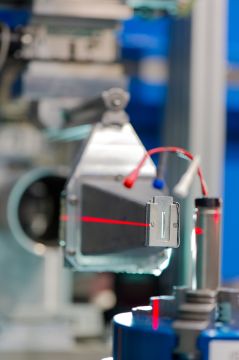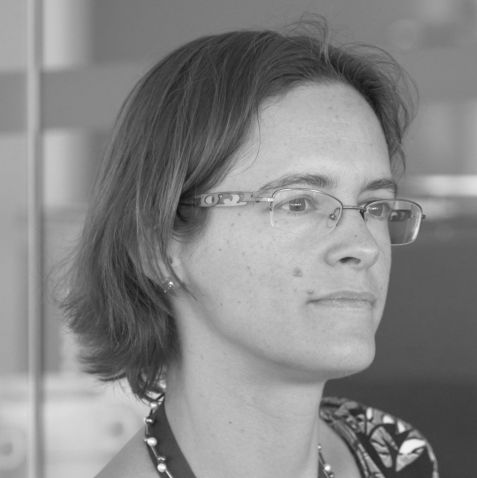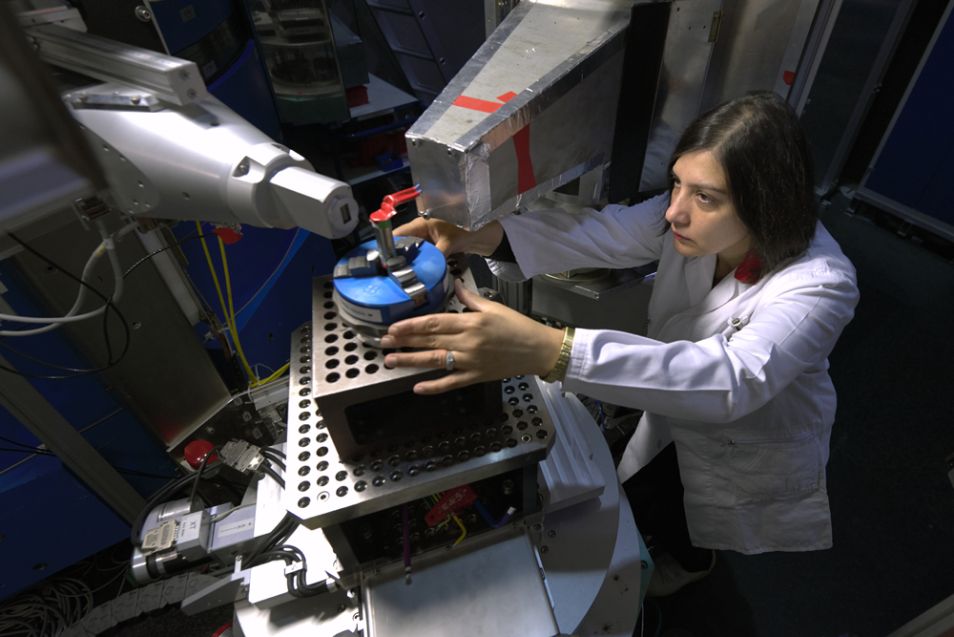MLZ is a cooperation between:
 > Technische Universität München
> Technische Universität München > Helmholtz-Zentrum Hereon
> Helmholtz-Zentrum Hereon
 > Forschungszentrum Jülich
> Forschungszentrum Jülich
MLZ is a member of:
 > LENS
> LENS > ERF-AISBL
> ERF-AISBL
MLZ on social media:

MLZ (eng)
Lichtenbergstr.1
85748 Garching
“Teamwork to balance work and family life“
Neelima Paul knows what an empty battery looks like from the inside. She is conducting research to ensure that the storage units for electric cars and solar power will live even longer and release more energy in the future. Her own life battery is virtually tireless. She works full time as a scientist at the Heinz Maier-Leibnitz Zentrum, has had two children while working on her doctorate and, as a native Indian, has acclimatized to Germany in a short time. This is only possible with teamwork at home and a lot of discipline at work, says the researcher.
Dr. Neelima Paul works towards achieving longer lifetimes and higher energy densities – for Li-ion batteries. She herself is full of energy and indefatigable. Born 1975 in Bombay, India, Neelima was already captivated by science as a child: „I spent part of my childhood at my father’s workplace, a research centre in Bombay. When I saw people with a passion for their work, who did not care if it was day or night, I knew that I wanted to be a scientist”. After a Master’s degree in physics, Neelima went for a career in science “to be part of something bigger and work with colleagues who are equally passionate”, she says. As a budding material scientist, she investigated metallic glasses using Mössbauer spectroscopy and X-ray scattering methods at synchrotron sources. When her husband Dr. habil. Amitesh Paul moved to Forschungszentrum Jülich, Germany, to work as a Post-Doc for Nobel laureate Professor Peter Grünberg, Neelima Paul joined Professor Bert Voigtländer’s group there for a PhD position in 2001.
A matter of pride
Coming from India to Germany was “no culture shock”, she says. Apart from some first language issues, Neelima detected a difference in work culture. “In Jülich, everybody was totally quiet at work, whereas in India people talk often while working. It was unusual for me to only talk at lunchtime”. Another difference that she had to get used to was that women in Germany are expected to do the heavy work alone. “When I tried to lift something heavy, my technician said that I had to do it alone. In India, women are not expected to do so,” Neelima recalls. “Meanwhile, I think it is a matter of pride that German women do not like to be dependent on a man and I admire this.” Another thing Neelima appreciates in German work culture is the discipline. “Discipline was something I have always liked very much, and I did not find enough of it in India. But in Germany, for example, deadlines are really maintained.”
Project on retinal transplants for blind

The STRESS-SPEC materials science diffractometer at FRM II with a Li-ion cell in the slide. © A. Heddergott / TUM
After her PhD in Jülich on semiconductor research, Neelima characterized polymer-liquid interfaces with infrared and fluorescence spectroscopy at Helmholtz Zentrum Berlin (HZB). Leading a project on artificial retinal transplants for blind people, she used neutron reflectivity in Garching and Berlin to study polymers, which could selectively bind neurotransmitter molecules. This lead to an understanding of where these neurotransmitter molecules accumulate within polymers. When she joined the group of Professor Peter Müller-Buschbaum in 2011 at the Technical University of Munich (TUM), her interest grew even more towards advanced X-ray and neutron scattering techniques.
Battery research using neutrons
In 2013, Neelima’s focus changed to Energy Research when she joined the Advanced Materials Group for TUM at the Heinz Maier-Leibnitz Zentrum (MLZ). Since then, she specializes in Li-ion batteries for various projects. “In the first project, we aimed to change the morphology of the anode material in order to have a longer battery lifetime, and confirmed a lower active Li loss with neutrons”, she explains. With the battery producer VARTA, even industry took part in the research project at MLZ. In a second project, the aim was to obtain higher energy densities in batteries by incorporating silicon within graphite anodes and using layered oxides as cathodes. “My role was to investigate aging processes in batteries whose electrode materials had been selectively modified, using X-ray and neutron methods.”
“You have to perform better than your male colleagues”
Both of Neelima’s children were born during her PhD. How she managed? “With my husband in a team, it worked well. I could and still can go to conferences with a free heart because I know that my husband is capable to take care of the children.” Finding the first post-doc position was rather difficult, Neelima admits: “As soon as the male employers found out that I have two small children, they presumed I would not be capable to work full-time.” Finally she was offered a chance by Dr. Martha Lux-Steiner, a female Professor at HZB, and never let her down “I knew that it was important to work in the evenings, on weekends, and sometimes even on holidays. Keeping in mind that nobody should feel that I am less efficient at work because I am a mother, I always said to myself: ‘You have to perform better than your fellow male colleagues’.”
Safer batteries
In her different projects at MLZ, Neelima characterized batteries for stationary storage systems as well as for vehicles using neutron diffraction, neutron reflectivity, small-angle neutron scattering, and neutron depth profiling. In a new joint German and US project, she finally came to the “Holy Grail of Lithium batteries” as she says. Together with her colleagues, she works on developing Li-metal based batteries. The difference is in the electrolyte: instead of being a liquid as usual in Li-ion batteries, the electrolyte is solid. “This makes the batteries safer because it reduces their flammability and leakage risks”, says Neelima, with hints to past stories of burning cell phones in aircraft.
Brennende Handys sollen bald der Vergangenheit angehören
In den vergangenen acht Jahren hat Neelima Paul sowohl Akkus für Elektrofahrzeuge als auch stationäre Energiespeicher mit den verschiedensten Neutronenmethoden unter die Lupe genommen: Diffraktion, Reflexion, Kleinwinkelstreuung und Neutronentiefenanalyse. Inzwischen ist sie, wie sie selbst sagt, beim „Heiligen Gral“ der Lithium-Akkuforschung angelangt: Gemeinsam mit deutschen und US-Kolleginnen und Kollegen entwickelt sie metallische Lithium-Ionen-Batterien. Der Unterschied zu den handelsüblichen Akkus: Der Elektrolyt ist nicht flüssig, sondern fest. „Das macht die Akkus sicherer, weil sie nicht so leicht brennbar und dichter sind“, sagt Neelima Paul. Bilder von brennenden Handys in Flugzeugen sollen damit bald der Vergangenheit angehören.

Picture on the left: Neelima Paul investigated such 18650-type cylindrical batteries together with the battery manufacturer VARTA. © Andreas Heddergott / TUM // Picture on the right: An employee shows a rack of the "Energy Neighbor" stationary energy storage system. It is located in the Upper Bavarian community of Kirchdorf. With a storage capacity of 200 kWh, it can store locally generated solar electricity on site. The MLZ was also involved in the EEBatt project with Neelima Paul and colleagues. © Andreas Heddergott / TUM
More information
Related News

Andrea Voit
Press & Public
Relations
FRM II
MLZ is a cooperation between:
 > Technische Universität München
> Technische Universität München > Helmholtz-Zentrum Hereon
> Helmholtz-Zentrum Hereon
 > Forschungszentrum Jülich
> Forschungszentrum Jülich
MLZ is a member of:
 > LENS
> LENS > ERF-AISBL
> ERF-AISBL
MLZ on social media:



